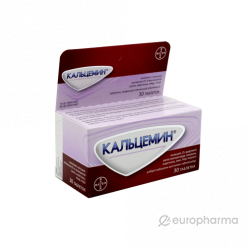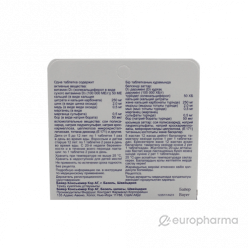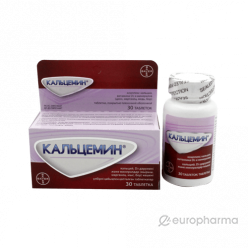
Everything you want to know about our company.



Instructions for medical use
Calcemin®
Trade name
Calcemin®
International nonproprietary name
No
Dosage form
Film-coated tablet
Composition
One tablet includes:
active substance:
Vitamin D3 (equivalent of cholecalciferol)
in the form of dry vitamin D3 (100 000 MU/g) 50 ME
calcium (in the form of calcium carbonate and calcium citrate)250 mg
zinc (in the form of zinc oxide)2,0 mg
copper (in the form of copper oxide)0,5 mg
manganese (in the form of manganic sulphate)0,5 mg
boron (in the form of sodium borate)50 mcg
adjuvants: soyameal polysaccharide, sodium laurylsulfate, silicium dioxide colloidal, cross-carmellose sodium, microcrystalline cellulose, stearic acid, magnesium stearate;
shell: hypromellose, triacetin, mineral oil, sodium laurylsulfate, titanium dioxide (Е 171), magnesium silicate.
Description
Pink oval film-coated tablet with cut on one side, white inside when broken.
Pharmacotherapeutic group
Gastro-intestinal tract and metabolism. Mineral supplements. Calcium drugs. Calcium drugs with other drugs.
Code АТХ А12АХ
Pharmacological properties
Pharmacokinetics
Calcium is absorbed from proximal part of small intestine due to active Vitamin-D-depending transfer mechanism.
Cholecalciferol is absorbed form small intestine with bile acids. In blood Vitamin D3 and its metabolites are absorbed with special transport globulin – Vitamin D3 binding protein – or with albumens. Elimination of cholecalciferol is slow (within 30 days), but its active metabolites (calcidiol, calcitriol) disappear significantly faster (within 7-10 days). They pass biological transformation in liver and formed metabolites are excreted with urine.
Pharmacodynamics
Calcium – important structural component of bone tissue. Provides interneuronic and nervimuscular conductivity, heart automatism, takes part in decrease cross-striated muscles and unstriped muscles, blood clotting. Calcium carbonate is salt with the greatest content of elementary calcium. Calcium citrate increases drug bioavailability for patient with hypoacide gastrointestinal system, achlorhydria, with use of Н2-histamine blocker, decreases risk of lithiasis in urinary tract in case of long use, has high antiresorptive potential due to inhibition of parathyroid hormone, has cardio protection activity due to decrease of cholesterin level.
Vitamin D3 (cholecalciferol) increases absorption of calcium in small intestine, stimulating synthesis of calcium binding protein, increases reabsorbtion of calcium in kidney tubules. Vitamin D3 activates processes of remodeling of bone tissue by increase of synthesis of collagen, where phosphoric calcareous salt deposition takes place; stimulates synthesis of osteocalcin – the main non-collagenic protein of bone tissue required for bone formation and calcium deposition in bones. Influences on functional condition thyroid, parathyroid, sexual glands providing calcareous infiltration of bones of skeletal system.
Magnesium takes part in metabolism of bone tissue, transfer of nervous excitement, supports removal of xenobiotics and products of its metabolism from body, activates ferments of carbohydrate metabolism, prevents from bone absorption, restrain calcium deposition in blood vessel walls, heart valve, muscles, urinary tract. Included in system of antioxidant protection of body.
Zinc is co-factor of more than 200 ferments that take part in protein synthesis, nucleic acid responsible for genic expression, growth and cell repair. Regulates secretion ofcalcitonin by parafollicular cells of thyroid. Zinc takes part in productionofosteogenetic cells of collagen of 1 type – the main element of bone matrix, indluences on process of bone remodeling,on genital function, particularly, on activity of estrogen.
Copper takes part in construction of important protein of connective tissue – collagen and elastin that forms matrix of bone and cartilaginous tissue, being activator of alkaline phosphatase.
Manganese normalizes synthesis of glycosaminoglycan necessary for formationof bone and cartilaginous tissue. Duplicates calcium saving functions of Vitamin
Boracium regulates activity of parathyroid hormone and exchange of calcium, magnesium, phosphor andcholecalciferol, influences on activity ofestradiol.
Dosage and methods of use
Ingest. Tablet shall be ingested in whole during meal with enough water (200 ml of water).
Children 5–12 years of age should take 1 tablet once a day with meals.
Adults and children over 12 years old - 1 tablet twice a day.
Maximal single dose – 2 tablets.
Maximal daily dose – 3 tablets.
Maximal daily dose for pregnant woman – 2 tablets.
Period of treatment is defined by a doctor.
Adverse reaction
Rare stomach ache, retention of feces, diarrhea, bloating, nausea and vomit, rash, nettle rash, edema, irritation, cardio respiratory distress. Very rare acute anaphylaxis.
After long use of the drug there can be increased level of calcium in urine and concentration of calcium in blood serum that shall be controlled by doctor.
Contraindications
Drug interaction
Prior to use of Calcemin patients taking any other drugs shall consult with a doctor.
Calcium salt can interact with a lot of substances by changing level of gastric pH and rate of gastric emptying as well as by formation of complexes with specific substances that lead to decrease of absorption of both substances.
Substances that form complexes:
Cardiac glycoside and blockers of calcium channels: hypercalcemia increases risk of fatal anisorhythmia in case of use with cardiac glycoside such as digoxin and decreases effectiveness of blockers of calcium channels such as verapamil in case of continuous arrhythmia. Patients taking calcium and/or Vitamin D and the specified drugs at the same time are recommended to control level of calcium in blood serum.
Protease inhibitors (for example, amprenavir, atazanavir and tipranavir): In case of use of the drugs containing calcium or magnesium including buffer medicinal product together with some inhibitors of protease, concentration of all these substances in blood plasma can be decreased. Inhibitors of protease should be taken 2 hours prior to or in 1 hour after use of products containing aluminum, calcium or magnesium.
Thiazide diuretic decreases excretion of calcium with urine. Due to increased risk of hypercalcemia in case of simultaneous use of thiazide diuretic and calcium drugs it is recommended to control level of calcium in blood serum regularly in case of long treatment.
Some drugs can decrease gastro-intestinal absorption of Vitamin D. Division of use of these drugs and vitamin D at least 2 hours prior to and 4-6 hours after use of vitamin D will help minimize such interaction.
Interaction with food/ accessory food substance:
Special indications
Dose of the drug shall not exceed recommended daily dose.
Patients receiving other vitamins and multivitamin drugs containing Vitamin D or calcium and any other drugs or being under medical supervision should consult with a doctor prior to use of this drug.
It is required to be careful and do not exceed cumulative volume of 2500 mg of calcium and 4000 MU of Vitamin D.
During long treatment by combined drugs of calcium and Vitamin D it is necessary to control level of calcium in blood serum and urine as well as kidney function after measurement of content of creatinine in blood serum, especially forelderly patients and in case of accompanying therapy of cardiac glycoside, calcium-channel blockers and/or thiazide diuretics.
Immobilized (disabled) patients shall carefully take combined vitamin drugs with osteoporosis due to increased risk of hypercalcemia.
Pregnancy and lactation
It is considered that Calcemin Advance is safe during pregnancy and lactation period udring use according to recommended doses, but shall be taken upon the recommendation of doctor.
Do not exceed recommended dose, because chronic overdosing can be dangerous for fetus and infant.
During pregnancy daily dose shall not exceed 1500 mg of calcium and 600 MU of vitamin D.
Do not take more than 2 tablets per day during pregnancy and lactation.
Vitamin D and calcium are excreted with breast milk. It is necessary to take into account if child receives any corresponding supplements.
Effects on ability to drive and use potentially dangerous machines
No effect.
Overdosage
Symptoms – in rare cases there can be acute headache, clouding of consciousness, gastrointestinal irritation (nausea, vomit, retention of feces, diarrhea).
In case of overdosage it is recommended to use symptomatic treatment – gastric lavage, large volume of water and diet with low level of calcium also it is necessary to stop treatment and consult with a doctor.
General use of calcium and vitamin D more than 2500 mg of calcium and 400 ME/day of vitamin D can lead to intoxication.
Patients with hypercalcemia or condition connected with hypercalcemia, renal insufficiency or tendency to stone disease are objects of intoxication by calcium and vitamin D with lower doses. Such patients should avoid use of this product.
Acute and long exceeding of dose of calcium and vitamin D, especially for predisposed patients can lead to hypervitaminosis D, hypercalcemia and hyperphosphatasemia.
Consequences include renal insufficiency, milk-alkali syndrome, calcinosis of vessels and soft tissues includingcalcinosis leading to stone disease.
Form of output and packing
30, 60 and 120 tablets are placed in vials made ofhigh-density polyethylene with screw cap made of high-density polyethylene with sealed membrane made of aluminium foil on paper basis, covered mixture of high-molecular heteropolymer of ethylene and vinyl acetate, laminated with foam polystyrene. Vial with medical use instruction in Kazakh and Russian shall be placed in carton package.
Storage conditions
Do not store above 25 °C.
Keep out of the reach of children!
Shelf life
3 years.
Do not use after the expiration date indicated on the package.
Conditions for drug supply
Without a prescription
Name and address of manufacturer
Contract Pharmacal Corporation, USA
135 Adams Avenue, Hauppauge, New-York 11788, USA
Name and country of the Registration Certificate holder
Bayer Consumer Care AG, Switzerland
Name and country of packer
Contract Pharmacal Corporation, USA
Name, address and contact data (telephone, fax, e-mail) of the organization receiving claims (offers) from consumers regarding the quality of products on the territory of the Republic of Kazakhstan:
«Bayer KAZ» LLP.
Timiryazev Street, 42, “Expo City” Business Center, Pav. 15
050057 Almaty, Republic of Kazakhstan
tel.: +7 727 258 80 40, fax: +7 727 258 80 39
e-mail: kz.claims@bayer.com
Name, address and contact data (telephone, fax, e-mail) of the organization responsible for post-registration supervision over the drug safety on the territory of the Republic of Kazakhstan:
«Bayer KAZ» LLP.
Timiryazev Street, 42, “Expo City” Business Center, Pav. 15
050057 Almaty, Republic of Kazakhstan
Tel: +7 701 715 78 46 – round the clock
Tel.: +7 727 258 80 40 (106) – during working hours
Fax: +7 727 258 80 39
e-mail: pv.centralasia@bayer.com
